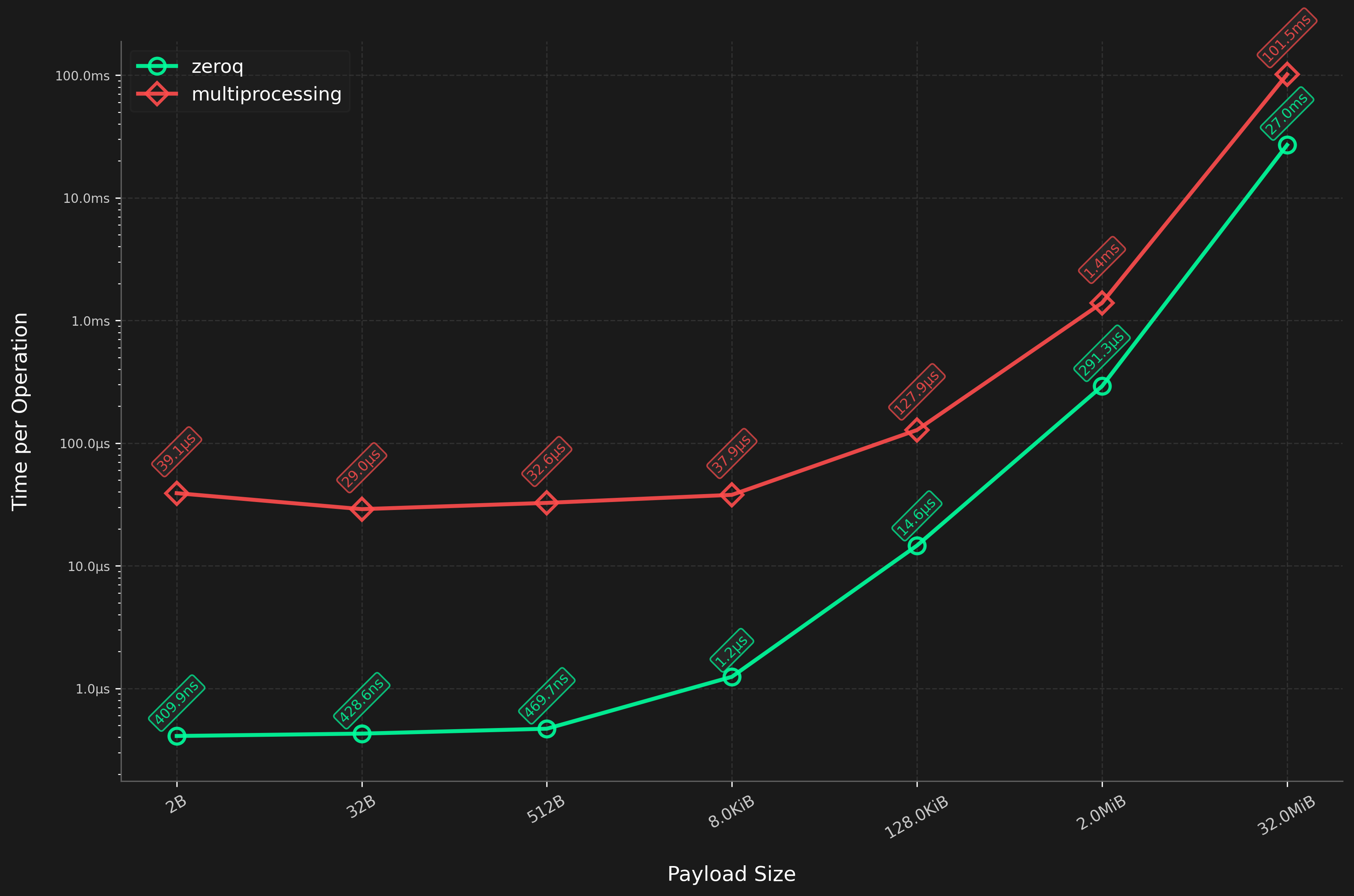zeroq is a high-performance, shared-memory, multi-producer/multi-consumer (MPMC) queue written in Rust with Python bindings. Designed for concurrent and inter-process communication, zeroq delivers low latency and strict FIFO (First-In, First-Out) behavior even under heavy load.
- Speed: Up to 90× faster data transfer compared to
multiprocessing.Queue. - Lock-Free Concurrency: Utilizes atomic operations for efficient, lock-free synchronization across threads and processes.
- Shared Memory Communication: Enables fast inter-process messaging without the overhead of kernel-based IPC.
- Flexible API: Supports both blocking (
put/get) and non-blocking (put_nowait/get_nowait) operations. - Predictable FIFO Ordering: Guarantees that elements are dequeued in the exact order they were enqueued.
- Python Bindings: Easily integrate with Python projects while leveraging Rust's performance and safety.
If pre-built wheels are available on PyPI, installation is as simple as:
pip install zeroqThe following benchmarks compare zeroq with Python's standard
multiprocessing.Queue across different payload sizes. Tests were conducted
on a GitHub Actions runner (Ubuntu latest) with Python 3.11. Each test measures
the time for a complete put+get operation cycle (1000 iterations).
zeroq demonstrates up to 90x faster performance compared to multiprocessing.Queue, especially for small payload sizes. This performance gain is achieved through shared memory and lock-free synchronization, eliminating the overhead of serialization and dynamic memory allocation.
zeroq is particularly well-suited for tasks that require fast, low-latency data exchange between processes, including:
- ML/AI Pipelines: Efficient data transfer between processes for image and video processing, such as inference in computer vision models.
- Multimedia Processing: Passing video frames or audio streams between processes in real-time applications.
- Real-Time Systems: Handling events, logs, telemetry, and signals where minimal latency and high throughput are critical.
- IoT and Embedded Systems: Fast transmission of fixed-size data blocks between processes on a single device.
By leveraging shared memory and avoiding unnecessary memory operations, zeroq provides a significant advantage in applications that demand high-speed, low-latency communication.
Once installed, you can easily integrate zeroq into your Python projects. Below is an example of video player.
To run this example, install OpenCV and FFmpeg:
pip install opencv-pythonMake sure FFmpeg is installed and accessible via the command line. You can download it from ffmpeg.org and add it to your system’s PATH.
import multiprocessing
import subprocess
import cv2
import numpy as np
from zeroq import Empty, Full, Queue
def producer(video_path: str) -> None:
"""Reads video frames via FFmpeg and pushes them to the shared queue."""
queue = Queue(
name='video-queue',
element_size=1920 * 1080 * 3,
capacity=16,
create=True,
)
process = subprocess.Popen(
[
'ffmpeg', '-re', '-i', video_path,
'-f', 'rawvideo', '-pix_fmt', 'rgb24', '-vf', 'scale=1920:1080',
'-vcodec', 'rawvideo', '-an', '-nostdin', 'pipe:1',
],
stdout=subprocess.PIPE,
stderr=subprocess.DEVNULL,
bufsize=1920 * 1080 * 3,
)
while True:
raw_frame = process.stdout.read(1920 * 1080 * 3)
if not raw_frame:
break
try:
queue.put(raw_frame, timeout=1.0)
except Full:
break
def consumer():
"""Retrieves frames from the queue and displays them using OpenCV."""
queue = Queue(name='video-queue', create=False)
while True:
try:
frame_data = queue.get(timeout=1.0)
except Empty:
break
frame = (
np.frombuffer(frame_data, dtype=np.uint8)
.reshape((1080, 1920, 3))
)
cv2.imshow('Video Stream', frame)
if cv2.waitKey(1) & 0xFF == ord('q'):
break
cv2.destroyAllWindows()
if __name__ == '__main__':
video_path = 'your_video.mp4'
multiprocessing.Process(target=producer, args=(video_path,)).start()
multiprocessing.Process(target=consumer).start()zeroq is distributed under the terms of the MIT License.
